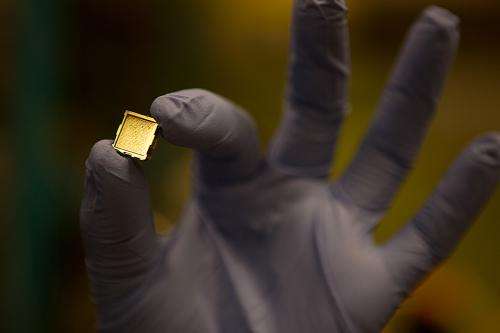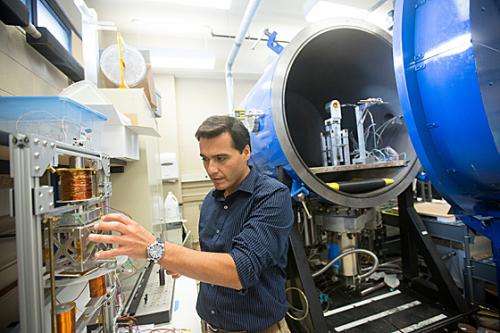October 28, 2013 report
MIT lab developing ion microthrusters for cubesats

(Phys.org) —The MIT News Office is reporting that the University's Space Power and Propulsion Laboratory (headed by Paulo Lozano) is seeing progress with micro-sized thruster design to power the next generation of self-propelled cubsats. Because traditional combustion or electric engines don't scale down well, the team has been testing ion electrospray thrusters that can be made as small as a postage stamp.
For most of their still relatively short history, satellites have been extremely expensive ventures, both to design and build and to launch into space. With the miniaturization of electronics, however, scientists see a way to reduce the costs associated with sending craft into orbit, and also for sending them into outer space—cubesats—satellites that are tiny versions of the older models. They range in size from a shoebox to a Rubix cube. The current versions are sent aloft (sans engine) as part of a cargo load carrying other bigger equipment and remain orbiting the planet for a short time, till gravity pulls them back down. To get more out of their investment, scientists would like to put an engine on the little satellites so that they could stay in orbit, or even be sent to other parts of the solar system. Current research has centered around plasma or colloid thrusters. The researchers at MIT believe that ion thrusters are the better bet. Their idea is to use solar power to generate a charge to electrify a very small amount of liquid propellant—releasing an ion stream through a nozzle—generating just enough thrust to change the course of a cubesat or push it forward. Four of the thrusters would be sufficient to provide both attitude control and propulsion.
Scientists believe it might be possible in the near future to send an entire fleet of cubesats into space for the amount of money it currently takes to send just one. In addition to designing tiny engines for them, engineers have also been hard at work designing other components necessary for fully utilizing such a satellite—one such example is the recently developed (also at MIT) inflatable antennae that greatly extends their range. Some suggest cubesats may even provide the long-sought solution to cleaning up space junk.

© 2013 Phys.org





















